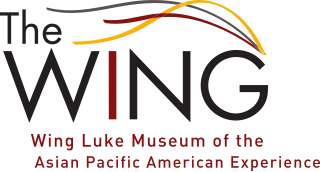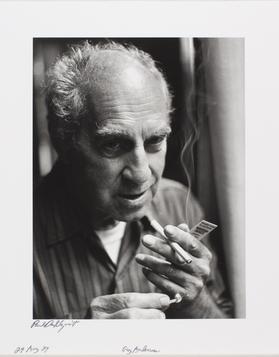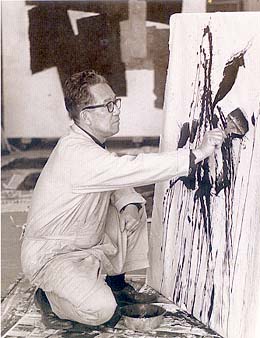
Ron Chew (born Ronald A. Chew, May 17, 1953) is an American consultant and community organizer. Chew is a leader in the community based model of museum exhibit development. He lives in Seattle, Washington.

Ron Chew (born Ronald A. Chew, May 17, 1953) is an American consultant and community organizer. Chew is a leader in the community based model of museum exhibit development. He lives in Seattle, Washington.
Chew was born in Seattle and attended Franklin High School and University of Washington. At the university Chew studied journalism and worked as a reporter at the Daily . In his senior year he applied for the position of editor but faculty gave the position to a white student who hadn't applied, prompting Chew to formally charge the Daily with discrimination. Shortly after, Chew left the UW to work at the International Examiner in Seattle's International District. Ultimately the lawsuit vindicated Chew but he did not return to UW to finish his studies. [1]
Chew began working as a reporter at the Examiner in 1975 and in 1977 he became editor. During his tenure he covered local events, social concerns and political issues faced by residents of the International District including substandard housing and health care for the poor and elderly and threats to the historic neighborhood from redevelopment. Chew's connections and involvement in the community through the Examiner honed his skills in community organizing for a cause. [2]
In the late 1980s Chew took on the Chinese Oral History Project, gathering numerous interviews with elderly Chinese Americans. The project became a traveling exhibit and led to his being recruited as the new director for the struggling Wing Luke Asian Museum (WLAM) in 1991. [3] Under Chew's leadership, the museum staff developed exhibits collaboratively with community members of varied backgrounds and created programs and displays that addressed and contextualized current issues.
In 2002 the University of Washington recognized Chew's innovative work since leaving college and awarded him an honorary Bachelor of Arts Degree. In 2004 Chew received the Ford Foundations "Leadership for a Changing World Award" and in 2005 the American Association of Museums included Chew in their "Centennial Honor Roll" for his work recasting the museum as a tool in the fight for social justice. [4] [5] [6]
In 2004 Chew, along with his staff, board and community volunteers, undertook a substantial expansion of WLAM by working toward acquiring a historic building in the International District as a permanent home for the museum. A successful $23 million capital campaign enabled the museum to purchase and renovate the East Kong Yick Building as their new home, which opened in 2008. At the conclusion of the campaign, Chew stepped down to pursue a new career as a community history consultant.[ citation needed ]
Since 2008 Chew has owned and operated Chew Communications, a community history and resource development consulting firm in Seattle. From 2008 to 2010 he was scholar in residence in the museology department at the University of Washington. He also served as executive director of the International Community Health Services Foundation in Seattle, to maintain access to affordable health care in the community, retiring at the end of 2020. [7]
Chew's recent publications include Community-Based Arts Organizations: A New Center of Gravity through Americans for the Arts outlining the emerging centrality of arts organizations as change agents in communities. [8] in 2009 and Remembering Silme Domingo and Gene Viernes: The Legacy of Filipino American Labor Activism in 2012. [9] Chew's autobiography, My Unforgotten Seattle, was published in fall 2020.

The Chinatown–International District of Seattle, Washington is the center of the city's Asian American community. Within the district are the three neighborhoods known as Chinatown, Japantown and Little Saigon, named for the concentration of businesses owned by people of Chinese, Japanese and Vietnamese descent, respectively. The geographic area also once included Manilatown.
The International Examiner is a free biweekly Asian American newspaper based in Seattle, Washington's International District. It was founded in 1974 by Gerald Yuasa and Lawrence Imamura to serve what the founders thought were the business interests of the Asian American community in Seattle's International District.

Wing Chong Luke was a Chinese-American lawyer and politician from Seattle.

The Wing Luke Museum of the Asian Pacific American Experience is a history museum in Seattle, Washington, United States, which focuses on the culture, art and history of Asian Pacific Americans. It is located in the city's Chinatown-International District. Established in 1967, the museum is a Smithsonian Institution affiliate and the only pan-Asian Pacific American community-based museum in the country. It has relocated twice since its founding, most recently to the East Kong Yick Building in 2008. In February 2013 it was recognized as one of two dozen affiliated areas of the U.S. National Park Service.
The Alaskeros are Filipino seasonal migrant workers in the United States and their descendants. They worked in salmon canneries in Alaska during the summer, and on farms in Washington, Oregon, and California during the rest of the year. The Alaskeros were instrumental in the formation of the first Filipino-led union in the U.S., the Cannery Workers and Farm Laborers Union, Local 7.

Guy Anderson was an American artist known primarily for his oil painting who lived most of his life in the Puget Sound region of the United States. His work is in the collections of numerous museums including the Seattle Art Museum, the Tacoma Art Museum, and the Metropolitan Museum of Art. He has been called "Perhaps the most powerful artist to emerge from the Northwest School".

Hing Hay Park is a 0.64-acre (2,600 m2) public park in the Chinatown–International District neighborhood of downtown Seattle, Washington, United States. The park is located on the north side of South King Street between 6th and Maynard avenues, east of Union Station and the Historic Chinatown Gate. It was built in 1973 and includes a pavilion, community games, and two gateways.

Robert Alan Hasegawa is an American labor leader and politician serving as a member of the Washington State Senate, representing the 11th Legislative District since January 2013. Hasegawa is a lifelong resident of Seattle's Beacon Hill. He previously served in the Washington State House of Representatives, and is retired from the Teamsters Union where he was a member and union leader for over 32 years.

911 Media Arts Center is a non-profit media arts and access center located in Seattle, Washington. 911 Media Arts Center was incorporated on August 14, 1984, to support the expressive use of media tools through training, equipment, and access grants. The organization also provides a forum and venue for those working in the new media disciplines. The center is a member-supported non-profit organization and receives other funding from education tuition and state, city, and county grants, along with grants from private foundations and individuals.

The East Kong Yick Building is one of two buildings erected in Seattle, Washington's Chinatown-International District (ID) by the Kong Yick Investment Company. A four-story hotel in the core of the ID, with retail stores at ground level, the East Kong Yick was created by the pooled resources of 170 Chinese American pioneers. In, 2008, the building reopened as the home of the expanded Wing Luke Asian Museum.

Margaret Levi is an American political scientist and author, noted for her work in comparative political economy, labor politics, and democratic theory, notably on the origins and effects of trustworthy government.

Paul Horiuchi was an American painter and collagist. He was born in Oishi, Japan, and studied art from an early age. After immigrating to the United States in his early teens, he spent many years as a railroad worker in the Western U.S. In 1946, he moved to Seattle, Washington, where he eventually switched his focus from painting to collage and came to be associated with the "Northwest School" of artists. In his mid-forties, he was finally able to devote himself to art full-time, his unusual collage style becoming very popular in the 1950s and 60s. He continued creating art at his studio in Seattle until succumbing to Alzheimer's-related health problems in 1999.
The Seattle Asian American Film Festival was founded in 1985 and has been revived over the years by different producers. The current iteration was founded in 2012 and made its debut in 2013 by co-founders Kevin Bang and Vanessa Au. It is a revival of of the previously running Northwest Asian American Film Festival, which was directed by Wes Kim from 2003 to 2007 and which had experienced a five-year hiatus. The inaugural film festival was also held at the Wing Luke Asian Museum from January 25 to 27, 2013. The festival is currently run and directed by Executive Director, Vanessa Au, and Festival Director, Victoria Ju.

Greater Seattle has had a Chinese American community almost since its founding in 1851. Chinese workers arriving in the 1860s were welcomed, because the Seattle area was sparsely settled and workers were needed; within a few decades, however, newly arrived white settlers resented the Chinese workers, and there were several anti-Chinese riots as the whites attempted to expel the Chinese from the area. Chinese settlement persisted, with the immigrants settling in a well-defined Chinatown where they maintained their culture through family groups, associations, and churches. In the mid-20th century Chinese Americans joined with other immigrant groups to oppose racial discrimination. In 1962 a Chinese American became the first person of Asian ancestry to hold elective office in the state of Washington.
Louie Gong is a Canadian American visual artist, activist, public speaker, educator, and entrepreneur. His work focuses on Indigenous and multiracial identity, exploring race and identity through art, and expanding business leadership and capacity for Native artists.

Silme Domingo was a Filipino American labor activist. With Gene Viernes, he was murdered in Seattle on June 1, 1981, while attempting to reform the Local 37 of the International Longshoremen's and Warehousemen's Union (ILWU).

Midori Kono Thiel is a Japanese American calligrapher based in Seattle. She grew up on Maui. She received her bachelor of arts and master of fine arts from the University of California, Berkeley. She has exhibited at the De Young Museum, San Francisco; Tokyo Metropolitan Art Museum; Seattle Art Museum; Portland Art Museum; Henry Art Gallery, Seattle; Cheney Cowles Art Museum, Spokane; and the Wing Luke Museum of the Asian Pacific American Experience, Seattle.
Chris Delarna Mensalvas, also archived as Chris D. Mensalvas and Chris D. Mensalves was a Filipino American union organizer most active during the 1940s and 1950s. A communist and leader of the immigrant Filipino labor movement in the Pacific Northwest, Mensalvas was closely associated with famous Filipino American author and activist Carlos Bulosan as well as Ernesto Mangaoang and Philip Vera Cruz.
A community museum is a museum serving as an exhibition and gathering space for specific identity groups or geographic areas.
The Northwest Asian American Theatre, originally Theatrical Ensemble of Asians and then Asian Exclusion Act, was an Asian-American theatre in Washington state from 1972 to 2004.